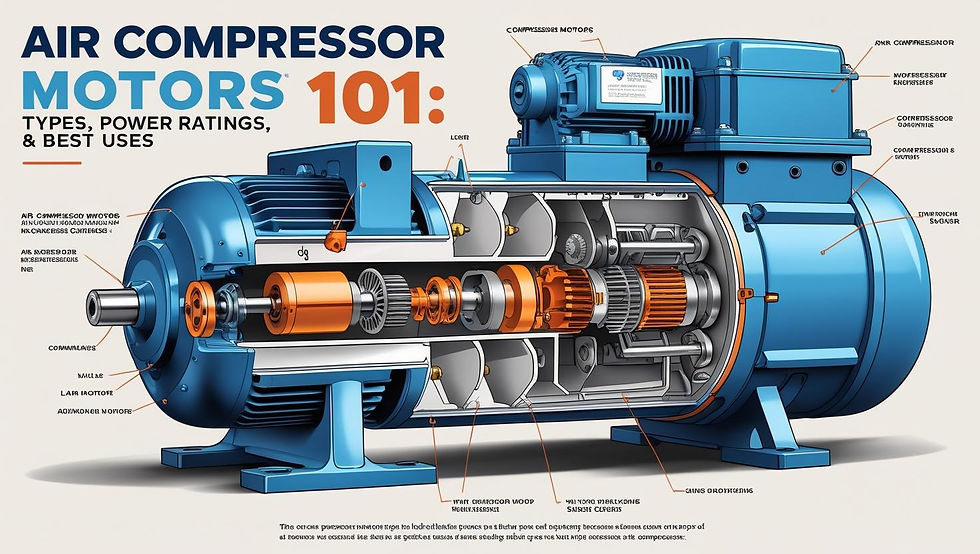Understanding Elevator Motor Specifications: A Beginner’s Guide
- limaindustial
- 3 days ago
- 4 min read

✨ Why Specifications Matter
Selecting the correct elevator motor isn’t just about horsepower—each technical spec plays a critical role in safety, performance, efficiency, and lifecycle cost. Misinterpreting specs can lead to operational issues, higher energy use, unexpected downtime, and even safety hazards.
1. Horsepower (HP) / Kilowatts (kW)
What it means: Measures the motor’s power capacity—its ability to move the elevator car and its load.
Why it matters: Underpowered motors may struggle with heavy loads or steep rises; overpowered motors waste energy and cost more.
How to interpret: Choose motors rated for your building’s total elevator load (car + max passengers + counterweight offset) and typical travel distance. Match the motor size to peak demand use.
2. Rated Speed (RPM)
What it means: The Revolutions per minute the motor runs at its operating point.
Why it matters: Affects how quickly the elevator moves and how gearing is configured.
How to interpret: Know the building’s floor-to-floor distance and desired travel time. Then calculate the required RPM or choose motors that match the cabin's speed via gearbox or pulley.
3. Torque
What it means: Rotational force the motor delivers, expressed in Newton-meters (Nm).
Why it matters: Crucial for starting the elevator, overcoming static friction and gravity.
How to interpret: Look for rated and pull-out torque specs. The rated torque must exceed the startup torque requirement (lifting full load). For smooth rides, ensure a torque reserve of ~20–30%.
\
Read cost analysis of geared vs gearless motors to understand their difference and to know which to use when.
4. Duty Cycle / Rating
What it means: Classification of how often and intensively the motor can run (e.g., continuous, intermittent, short-time).
Why it matters: Ensures the motor isn’t undersized or overheated under elevator usage patterns.
How to interpret: Most elevators run continuously (S1). For service elevators or freight lifts, a higher-duty rating may be needed to handle heavy, frequent operation.
5. Insulation Class
What it means: Indicates temperature tolerance of winding insulation, rated from A to H (A = 105 °C; H = 180 °C).
Why it matters: High-winding temps reduce lifespan; tight spaces and poor ventilation make this a key spec.
How to interpret: Choose Class F or H for hot environments or ventilated machinery space; Class B or E is sufficient for cooler or well-ventilated areas.
6. Efficiency & IE Classification
What it means: Efficiency rating — IE1 (standard), IE2 (high), IE3 (premium), IE4 (super-premium).
Why it matters: Higher efficiency reduces energy use, especially in high-use elevators, saving money long-term.
How to interpret: For green buildings or energy-conscious upgrades, opt for at least IE3. Combine with regenerative drives for maximum savings.
Brands like Lema Industrial, which are certified and have complete knowledge of these details, can only be trusted. Therefore, do your research before purchasing.
7. Frame Size & Mounting
What it means: Physical dimensions of the motor housing per IEC or NEMA standards.
Why it matters: Dictates if the motor fits the available machine room and matches shaft or pulley alignments.
How to interpret: Measure your current rig or check the spec sheet drawing. Ensure baseholes and mounting bolt patterns align.
8. Enclosure / IP Rating
What it means: Protection level against dust and water ingress (e.g., IP55, IP66).
Why it matters: Prevents corrosion, keeps wiring clean (particularly in machine rooms with leaks, dust).
How to interpret: Choose IP44 for clean, indoor environments; IP54 or higher for humid, dusty, or outdoor shaft environments.
9. Voltage & Frequency Compatibility
What it means: Operating voltage (e.g., 400 V, 480 V) and grid frequency (50 Hz / 60 Hz).
Why it matters: A mismatch can damage the motor or make it inefficient.
How to interpret: Match motor specs to building transformer output and VFD (Variable Frequency Drive) setup. Consider 3-phase compatibility.
10. VFD Compatibility & Regenerative Braking
What it means: Support for variable speed drives and the ability to feed energy back (regeneration).
Why it matters: VFDs enable smooth starts/stops, speed control. Regeneration reduces peak power draw.
How to interpret: For modern lifts, ensure motor is VFD-rated, and consider models with built-in regen options, especially in high-rise or express elevators.
Putting It All Together: A Spec Analysis Example
Spec | Value | Analysis |
Power | 15 kW (20 HP) | Suitable for 12-person, low-rise cabin |
Rated Speed | 1000 RPM | Matches 3 m/s climb with 80 mm sheaves |
Torque | 150 Nm | Covers starting torque safely |
Duty Cycle | Continuous (S1) | Fits high-traffic lobby usage |
Efficiency Class | IE3 | Meets energy regulation goals |
Insulation Class | F (155 °C) | Good for warmer machine room |
IP Rating | IP54 | Handles dust/fume moderately well |
Voltage/Frequency | 400 V / 50 Hz | Standard European grid |
VFD & Regen | Yes/Yes | Supports smooth travel & energy return |
This motor would be an excellent fit for mid-rise office or residential applications, with strong energy-saving potential and durability in moderate environments.
✅ Quick-Spec Selection Checklist
Estimate load & travel speed → Determine kW/HP & torque
Match RPM to the cabin sheave or gearbox
Choose the correct duty rating (S1 vs. heavy-use rating)
Opt for high efficiency (IE3/IE4) if possible
Select insulation based on temperature exposure
Confirm IP rating for dust or contamination
Ensure voltage/frequency + VFD compatibility
Look for regenerative options if energy efficiency is a priority
Final Thoughts
Understanding elevator motor specs helps ensure:
Smooth, safe operations
Energy efficiency and cost savings
Longevity and proper performance
Easy maintenance and code compliance
Getting it right means fewer emergency repairs, happier passengers, and peace of mind for operators. For purchasing purposes, a trusted brand really matters, and this brand is a wholesale elevator motor supplier that provides better service in the market.




Comentários